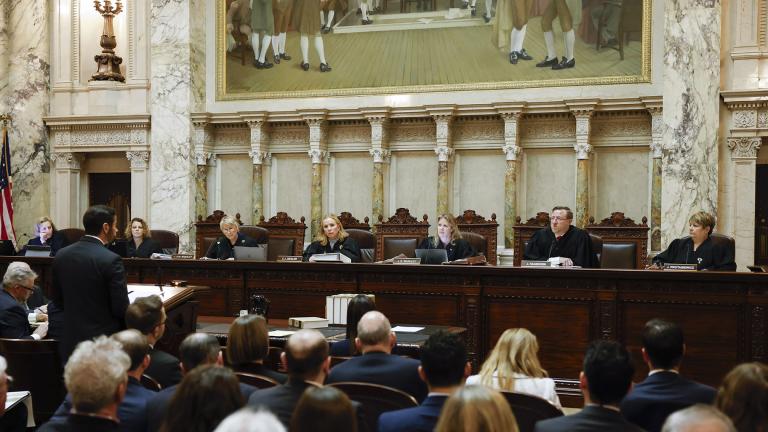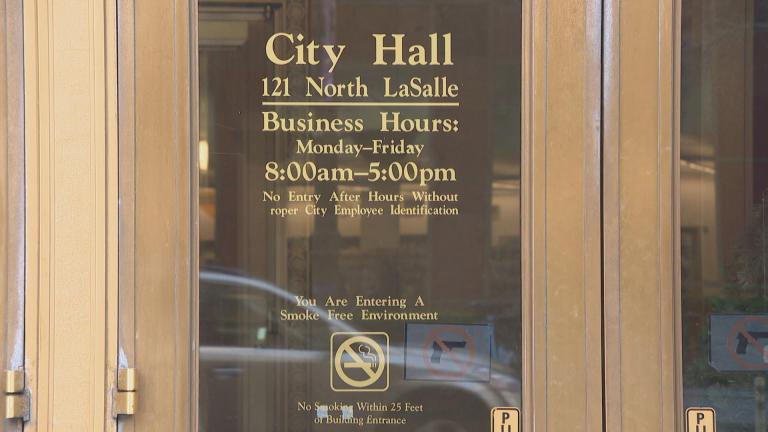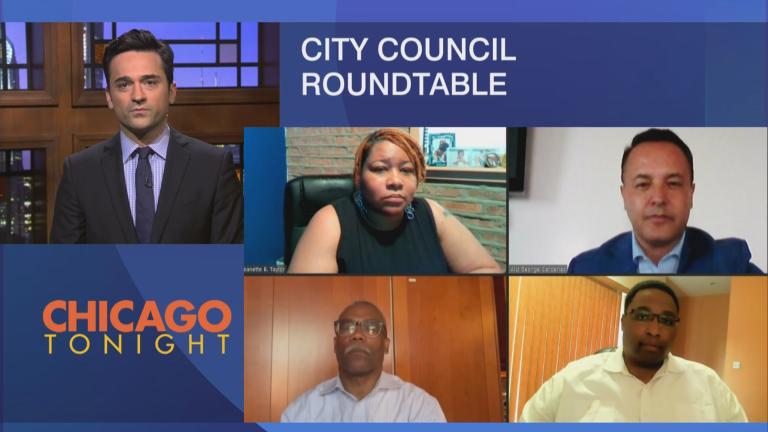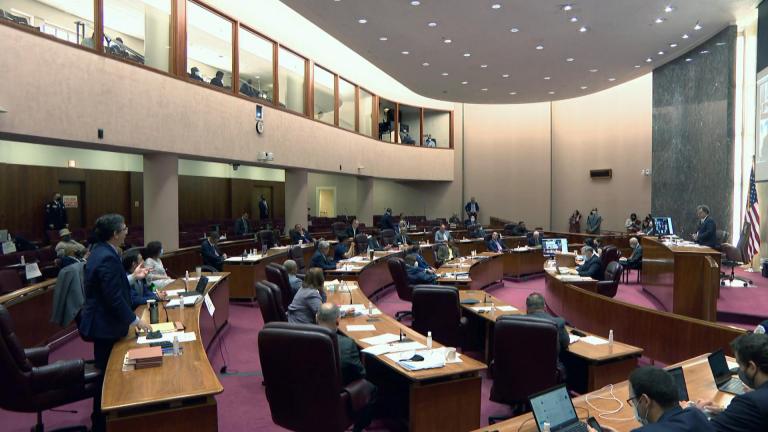Illinois Democrats are using their dominance in Springfield to help give their party an edge in maintaining control in Washington, D.C. while also lifting the political cachet of Latino voters in Chicago and the northern suburbs, but it comes at the expense of one of their own.
Late Thursday night and into the wee hours of Friday morning, chambers of the state legislature approved a new map of U.S. House districts – a congressional map that Republican state Rep. Jeff Keicher of Sycamore called “the most gerrymandered map in the country.”
“Your maps make a farce of democracy and the process is a charade,” Keicher said.
Because they control both chambers of General Assembly as well as the governor’s office, Illinois Democrats have wide berth to design a map without regard to Republican input, and they made the most of it.
Their final product, which still needs Gov. J.B. Pritzker’s signoff, is designed to send 14 Democrats and three Republicans to Congress from Illinois. If the strategy works, Democrats will gain a seat from Illinois while the GOP will lose two.
“We all know this is all about keeping (U.S. House Speaker) Nancy Pelosi in power and nothing to do with the people of Illinois,” state Rep. Avery Bourne, R-Morrisonville, said.
Illinois’ congressional delegation is currently split 13 Democrats to five Republicans.
Population gains in other states meant one of Illinois’ current 18 seats was lost to reapportionment.
“Obviously, the loss of a congressional seat following the 2020 census loomed large over this process,” Illinois House Redistricting Chair Rep. Lisa Hernandez, D-Cicero, said. “Tough decisions have to be made, but I believe the bill before us provides the strongest possible representation at the federal level for communities across the state.”
In weighing those decisions, Democrats put premiums on drawing districts advantageous to their party, protecting the 1st, 2nd and 7th districts designed to yield Black representatives despite a decrease in Illinois’ Black population, and creating a second district that props up a growing Latino population to elect representation of their choosing.
The 4th district has been represented by a Latino since it was designed for that purpose in the ‘90s. Former U.S. Rep. Luis Gutiérrez became Illinois’ first Hispanic Congressman in 1993; current Rep. Jesus “Chuy” Garcia won the seat in 2018 after Gutiérrez retired. More than 66% of the voters in the 4th district are Hispanic.
In the new map, the 3rd district will be 47% Hispanic and pointedly unites heavily Latino communities. From Chicago’s Logan Square on the eastern edge, it reaches through the Belmont Craigin neighborhood, covers Bensenville and Addison and over to West Chicago, then stretches up to catch Hanover Park, Bartlett and Elgin.
Names of prominent Latino politicians are already surfacing as potential contenders for the open 3rd district.
Readjusting Chicago and the suburbs in such a drastic fashion caused a domino effect.
The four iterations of a new congressional map made public by Illinois Democrats – and in particular last-minute changes that had to be made on Thursday in order to get Democratic lawmakers to coalesce behind a map – are a sign of the resulting difficulties.
State Sen. President Don Harmon had introduced as “final” a third draft at a committee Thursday morning, but by end of day another was released.
The true final map, which debuted mere hours before legislators voted on it, had what Harmon described as “relatively modest” differences from the earlier one, with “fine-tuning around the borders, most notably an exchange of voters between the 4th and 6th (districts).”
That fine-tuning dampens the future of freshman U.S. Rep. Marie Newman of LaGrange, who in 2020 bested longtime 3rd District Democratic Rep. Dan Lipinski in a heated primary.
In the earlier draft, both Newman and U.S. Rep. Sean Casten of Downer Grove were drawn into the 6th district.
The final version put Newman into the 4th district with its current representative, Garcia – a formidable district and a difficult opponent for Newman should she try to run there in next year’s election.
Newman blasted the map as a “clear attempt to appease one person” – a thinly veiled dig at Casten – “and a small handful of affluent insiders at the expense of workers and working families on Chicago’s Southwest Side and suburbs.”
“For the past month, hundreds of diverse community members from Chicago’s Southwest Side and suburbs have attended and overwhelmingly voiced their opinion at every single public input opportunity held by the Illinois General Assembly on the proposed congressional maps,” Newman said in a statement. “Illinois residents deserve fair representation and a fair map that includes public input — not one that turns a blind eye to it. This map undoubtedly does not live up to what Illinois residents deserve."
(Casten, meanwhile, issued a more prosaic statement about the outcome: “Each decade, our state assembly has an important constitutional obligation to ensure Illinoisans have congressional representation that reflects the vast geography and diversity of our state,” he said. “I remain focused on fighting for my constituents as we work to make historic investments in climate action, families, and workers for the sixth district of Illinois.”)
One of the communities at the heart of jostling: west suburban Western Springs.
At a Thursday morning hearing, Western Springs resident Meghann McEntee, with the Coalition for Change Illinois, testified that she was disappointed that the new map would “rip in half” her community of 12,000.
“Why would you put our tiny little town into two separate districts?” she said.
McEntee said she and other involved constituents had consistently shown up at public hearings on the congressional remap, but felt like their input was ignored.
“It would be great if we saw what we were saying being reflected in any way in a response with a new draft being proposed,” she said. “We’re trying to play ball, we are trying our best as civically engaged citizens to interact, and as citizens we hope that we are being heard and we would like to see that we are being heard.”
To Newman’s likely political demise, McEntee got her wish; the final map keeps all of Western Springs together.
The new 6th district covers Elmhurst, curves west and down in a rough C-shape to grab Lombard, Lisle, Downers Grove and Willowbrook, then dips south to include Oak Lawn, Chicago Ridge and Orland Park. Parts of the district jut out to capture Western Springs, sections near Midway airport, and parts of Chicago’s Beverly neighborhood.
During the Senate debate, Harmon made a point to say that Democrats had retooled the 6th district to unify all of Western Springs “in direct response” to a request.
That’s “proof that the system actually does work, that we hear from constituents and do our best to accommodate those (requests),” Harmon said. “Without doubt we have taken input from stakeholders of all shapes and sizes”
Harmon said Republicans were trying to place a “nefarious veneer” over the redistricting process, and that despite GOP criticism, it is normal, not “sinister,” to hold private map-making meetings ahead of public hearings.
Republicans say the public hearings were a sham, and noted there was no committee or hearing on the final map, meaning Illinois residents had no opportunity to weigh in on it.
At a hearing Thursday morning based on an older draft, Chicago resident Clare Duggan with Coalition for Change in Illinois complained that the process seemed designed to “quash public participation.” She had previously made known to lawmakers that she wanted to testify, but received an emailed invitation to the committee 12 minutes after it began.
“I just want to put it on record our concern, as a grassroots organization, that this process is making it quite difficult for individual citizens to be involved,” she said.
Newman isn’t the only incumbent whose aspirations could be jilted by a new map.
Republican incumbent Reps. Mike Bost and Mary Miller are grouped together in the new 12th district, a massive district geographically that covers almost the entire southern third of the state).
And Republican Reps. Adam Kinzinger and Darin LaHood are set to faceoff in the revamped 16th district, which looks like an upside down “G,” with a northern edge spreading from Illinois’ western border through Galena and Rockford, that dives south more than 160 miles and curves up and east to catch Streator, Morris and into Braidwood.
The 12th, 15th and 16th districts are the only three of Illinois’ new 17 Congressional districts where Republicans outperformed Democrats in top-tier statewide races, including the 2020 presidential contest and the 2018 gubernatorial race.
The U.S. Constitution does not require members of the U.S. House to reside in the district they represent; they merely have to live in-state.
That could allow incumbents to leapfrog to a different district, though a politician loses many of the advantages that come with incumbency if they have to depend on voters they’ve not previously represented.
The new large and mostly rural 15th district appears tailor-made as secure for Republican Rep. Rodney Davis of Taylorville, who’d been seen as a strong potential contender to take on Pritzker in next’ year’s governor race and had openly contemplated options outside Congress should he faced with an unfavorable district.
Meanwhile, with Democratic Rep. Cheri Bustos of the Quad Cities retiring, candidates from both parties are apt to battle to win the new 17th district, though by connecting downstate cities, Democrats have a boost.
Likewise, the 13th district – a narrow pipe of area that wrangles the urban centers of East St. Louis, Springfield, and Champaign – is beneficial to Democratic candidates. Nikki Budzinski, who’d served in a top position with President Joe Biden’s budget office and who as a top aide to Gov. Pritzker, has already secured backing of high-level Democrats in her campaign for the seat.
“The drawing of this congressional map enshrines the very most awful and deadly part of our politics today,” state Rep. Ryan Spain, R-Peoria, said. “We are divvying people up, we are creating outcomes where only the most extreme people that run for political office have any chance to prevail. It is an epidemic that is destroying our democracy. It is wrong when Republicans do it in other states, and it is so awfully wrong how the Democrats have doubled down on this strategy in the state of Illinois, a state that so badly needs help.”
The congressional map passed in the House with the bare minimum 71 votes needed – a three-fifths supermajority, even though with 73 Democratic members the party has a cushion.
State Rep. Angelica Guerrero-Cuellar, D-Chicago, was the sole Democrat to reject the map.
“I am the representation of my district, and I think I know what’s best and what should be included in what map and that didn’t happen,” she said.
In a speech one Republican said was gutsy, she intimated that some of her colleagues in Springfield and/or an official who holds higher office pressured her to accept how her 22nd state house district was treated in the congressional map, despite her concerns that the district’s Latino voters’ voices would be undercut.
“When someone says ‘I think I know more about politics than you do’ when you haven’t walked that door, you haven’t knocked there, you haven’t talked to those people and I have, that’s disrespectful and that is unprofessional,” Guerrero-Cuellar said. “It’s not that I’m saying I’m against the Democratic Party. Of course not. What I’m saying is there’s a level of professionalism that was not taken into account. I am a representation of the increase of the Latino population in the state of Illinois and that was not respected.”
Guerrero-Cuellar was appointed and sworn into office in February, after House Speaker Michael Madigan resigned and Madigan’s original successor resigned after three days in office.
Because of Newman and Guerrero-Cuellar’s opposition, State Rep. Kelly Cassidy, D-Chicago, pointedly did not cast a vote.
“The evolution of this map resulted in two women I strongly admire getting short shrift. I am strongly supportive of the creation of a second Latino district and know that hard choices had to be made to accomplish that, but I couldn’t bring myself to support a process that left two strong women leaders’ voices out,” Cassidy said in a statement. “As we work to ensure the map reflects the diversity of our state, it does a lot to accomplish that goal but falls short in terms of recognizing the need for more women in leadership roles as we watch the steady march towards the reversal of Roe v Wade.”
New districts must be retooled at all levels of government every ten years following a U.S. Census. The Chicago City Council is in the midst of redrawing wards; the Cook County Board in September easily approved its new map; the Illinois General Assembly this spring approved new state legislative maps, as well as new districts for the state Supreme Court.
A series of legal challenges could derail the new Illinois House and Senate maps, however. The Mexican American Legal Defense and Educational Fund (MALDEF) and Illinois Republicans sued shortly after Pritzker signed the legislative maps into law. Then the East St. Louis Branch of the NAACP, the Illinois State Conference of the NAACP and the United Congress of Community and Religious Organizations (UCCRO) filed a lawsuit earlier this month. Also in October, an ad-hoc group dubbed Illinois African Americans for Equitable Redistricting filed a complaint with the U.S. Department of Justice alleging the new state maps infringe upon Black residents’ voting rights.
Illinois pushed back its March primary until June 28, 2022, because state lawmakers waited until now to redo the congressional map.
Republicans and Democrats can begin to circulate petitions June 13 to get on the primary ballot; that paperwork must be submitted to election officials by March 14.
The shifted election timeline is likely behind a truncated election schedule for the General Assembly. According to a schedule released Thursday, the legislature is set to adjourn April 8 – more than seven weeks before the regular May 31 adjournment date.
Follow Amanda Vinicky on Twitter: @AmandaVinicky







